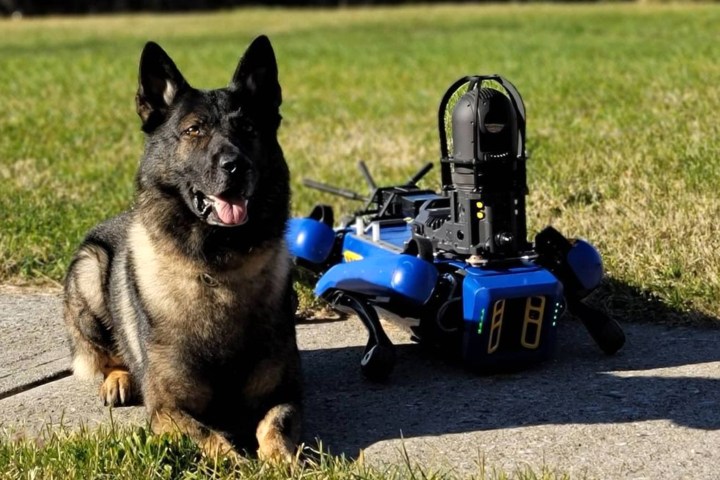
The classic 1987 movie RoboCop is said to be set roughly 20 years from now, but it looks like 2021 will be the beginning of the era of robotic law enforcement. A growing number of police departments around the country are purchasing robots for police work, and as this behavior becomes normalized, major concerns are starting to arise.
The NYPD purchased a robot dog earlier this year that is apparently capable of opening doors. The same kind of robot police dog has been tested out by the Massachusetts State Police. The use of drones by police departments has skyrocketed during the COVID-19 pandemic. Police departments around the country have purchased the weeble-wobble-looking robot Knightscope robot that apparently enjoys running over children’s feet and ignoring people who need help.
“Slowly introducing these robots as fun novelties is absolutely going to normalize a type of policing that is done by robot and by algorithm.”
Matthew Guariglia, a policy analyst at the Electronic Frontier Foundation, tells Digital Trends that the kinds of robots we’re starting to see police departments use are mostly for show, but that doesn’t mean there isn’t cause for concern. He has researched the companies that sell these robots extensively and argues that these robots are mostly a “public relations move” at this point. However, while they’re fairly innocuous right now, even these PR stunt police robots could open the door to something we should worry about.

“We’ve seen from the inside of the companies selling these robots that most of what they’re selling them based on is social media engagement and good press for your department,” Guariglia says. “Very little of it is about the actual policing the robot can do. I think by slowly introducing these robots as fun novelties that you can take selfies with it is absolutely going to normalize a type of policing that is done by robot and by algorithm.”
You might find a robot police dog to be cute, or perhaps think it’s funny when a robotic cop falls into a fountain, but what these machines could be bringing us closer to is much more pernicious. Guariglia says we could soon see a proliferation of different kinds of police robots, and accountability could become a major problem.
#Exclusive Now that’s some #dog! 4 legged, futuristic, first responder is helping NYPD w the most dangerous jobs. Starting at 4, Digidog, wait until you see what it can do! @abc7ny @NYPDnews @nypd_taru @nypd_esu #abc7ny #crime #technology #protect #officers #police #k9 #nyc pic.twitter.com/ewDjjPZkfr
— Kemberly Richardson (@kemrichardson7) December 10, 2020
“I worry about when we move out of the stage where police robots are just photo opportunities. We’re going to eventually have to confront the scenario in which robots that police have to make decisions, and when the time comes that a police robot makes the wrong decision — somebody gets hurt or the wrong person gets arrested — police robots are not people,” Guariglia says. “You can’t reprimand them.”
What if the robot falsely identifies them as a criminal and gets them arrested? Who will be held responsible for that? You can’t fire a robot or charge it with a crime.
It would not surprise me at all if we saw robot police dogs at protests that are equipped with pepper spray on their backs.”
Guariglia also notes that these robots can easily be outfitted with all kinds of surveillance technology, and they could become “roving surveillance towers.” He says a robot might be assigned to a high-crime neighborhood to conduct near-constant surveillance and call the police when it suspects it’s identified a criminal, whether it has or not.
Imagine you’re walking down the street and a police robot orders you to stop. It believes you’re wanted for a crime and calls the police on you. The police arrive and take you to jail. You’re released once they figure out that they’ve arrested the wrong person. They blame the robot’s algorithm, and there’s nothing you can do about it. It’s a dystopian future we could be fast approaching.
Furthermore, Guariglia says we might not be too far away from police robots starting to carry weapons, which would further complicate things. He notes that a police robot was already equipped with C4 and used to kill a mass shooter in Dallas in 2016, so it’s not unreasonable to assume we could see police robots equipped with weapons in the not-too-distant future.
“In extenuating circumstances, police are more than willing to impromptu weaponize robots, and we’ve already seen proposals over the years to put tasers or pepper spray on little flying drones, so it would not surprise me at all if we saw robot police dogs at protests that are equipped with pepper spray on their backs,” Guariglia says.

One possible solution to this problem would be communities preventing police departments from getting these kinds of robots in the first place. A city could adopt a Community Control Over Police Surveillance (CCOPS) ordinance, which would make it so the police department has to submit a request to the city council outlining what kind of technology it hopes to purchase before being allowed to purchase it. Guariglia says that police departments might be less inclined to purchase this kind of technology if they had to get approval from the public.
“We need more transparency and public control over what police departments spend their money on,” Guariglia says.
We won’t be seeing the kinds of humanoid robots that were featured in RoboCop patrolling our streets any time soon, but police robots are becoming a reality, and what appears harmless now could become very harmful in the near future. These robots could invade our privacy, get people falsely arrested, and even end up injuring or killing people in some circumstances. It may all depend on how the people respond to this impending threat.



